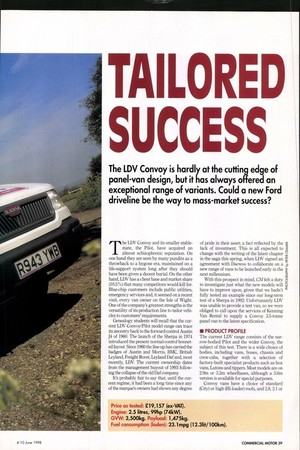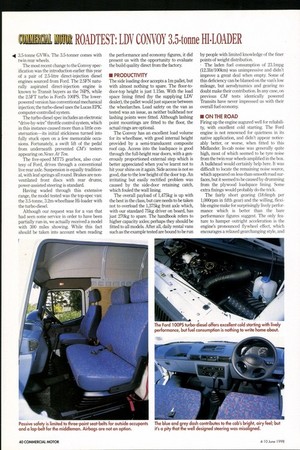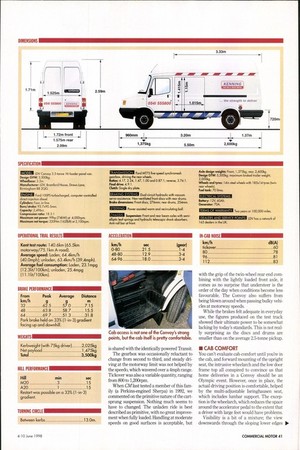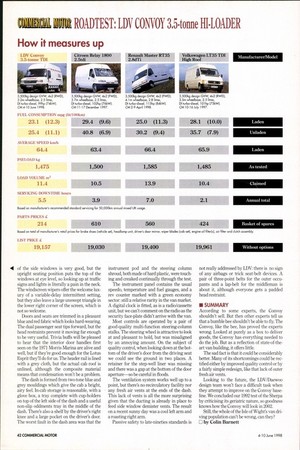TAILORED SUCCESS The LDV Convoy is hardly at the cutting
Page 41

Page 42

Page 43

Page 44

If you've noticed an error in this article please click here to report it so we can fix it.
edge of panel-van design, but it has always offered an exceptional range of variants. Could a new Ford driveline be the way to mass-market success?
Price as tested: £19,157 (ex-VAT).
Engine: 2.5 litres, 99hp (74kW).
GVW: 3,500kg. Payload: 1,475kg.
Fuel consumption (laden): 23.1mpg (12.31it/100km). The LDV Convoy and its smaller stablemate, the Pilot, have acquired an almost schizophrenic reputation. On one hand they are seen by many pundits as a throwback to a bygone era, maintained on a life-support system long after they should have been given a decent burial. On the other hand, LDV has a client base and market share (10.5%) that many competitors would kill for. Blue-chip customers include public utilities, emergency services and, it seemed on a recent visit, every van owner on the Isle of Wight. One of the company's greatest strengths is the versatility of its production line to tailor vehicles to customers' requirements.
Genealogy students will recall that the current LDV Convoy/Pilot model range can trace its ancestry back to the forward-control Austin J4 of 1960. The launch of the Sherpa in 1974 introduced the present normal-control bonneted layout. Since 1960 the line-up has carried the badges of Austin and Morris, BMC, British Leyland, Freight Rover, Leyland Daf and, most recently, LDV. The current ownership dates from the management buyout of 1993 following the collapse of the old Daf company.
It's probably fair to say that, until the current regime, it had been a long time since any of the marque's owners had shown any degree of pride in their asset; a fact reflected by the it lack of investment. This is all expected to change with the writing of the latest chapter in the saga this spring, when LDV signed an agreement with Daewoo to collaborate on a new range of vans to be launched early in the next millennium.
With this prospect in mind, CM felt a duty 8 to investigate just what the new models will ig have to improve upon, given that we hadn't fully tested an example since our long-term test of a Sherpa in 1992. Unfortunately LDV was unable to provide a test van, so we were obliged to call upon the services of Kenning Van Rental to supply a Convoy 3.5-tonne panel van to the latest specification.
• PRODUCT PROFILE The current LDV range consists of the narrow-bodied Pilot and the wider Convoy, the subject of this test. There is a wide choice of bodies, including vans, buses, chassis and crew-cabs, together with a selection of factory-built specialist products such as box vans, Lutons and tippers. Most models are on 2.9m or 3.2m wheelbases, although a 3.6m version is available for special purposes.
Convoy vans have a choice of standard (City) or high (Hi-loader) roofs, and 2.8,3.1 or 4 3.5-tonne GVVVs. The 3.5-tonner comes with twin rear wheels.
The most recent change to the Convoy specification was the introduction earlier this year of a pair of 2.5-litre direct-injection diesel engines sourced from Ford. The 2.5FN naturally aspirated direct-injection engine is known to Transit buyers as the 76PS, while the 2.5FT turbo is Ford's 100PS. The lower. powered version has conventional mechanical injection; the turbo-diesel uses the Lucas EPIC computer-controlled system.
The turbo-diesel spec includes an electronic "drive-by-wire" throttle control system, which in this instance caused more than a little consternation—its initial stickiness turned into fully stuck open on a few memorable occasions. Fortunately, a swift lift of the pedal from underneath prevented CM'S testers appearing on News At Ten.
The five-speed MT75 gearbox, also courtesy of Ford, drives through a conventional live rear axle. Suspension is equally traditional, with leaf springs all round. Brakes are nonventilated front discs with rear drums; power-assisted steering is standard.
Having waded through this extensive range, the model tested was the top-spec van: the 3.5-tonne, 3.2m-wheelbase Hi-loader with the turbo-diesel.
Although our request was for a van that had seen some service in order to have been partially run-in, we actually received a model with 300 miles showing. While this fact should be taken into account when reading the performance and economy figures, it did present us with the opportunity to evaluate the build quality direct from the factory.
• PRODUCTIVITY The side loading door accepts a lm pallet, but with almost nothing to spare. The floor-todoor-top height is just 1.15m. With the load space lining fitted (by the supplying LDV dealer), the pallet would just squeeze between the wheelarches. Load safety on the van as tested was an issue, as neither bulkhead nor lashing points were fitted. Although lashing point mountings are fitted to the floor, the actual rings are optional.
The Convoy has an excellent load volume for its wheelbase, with good internal height provided by a semi-translucent composite roof cap. Access into the loadspace is good through the full-height rear doors, with a generously proportioned external step which is better appreciated when you've learnt not to hit your shins on it again. Side access is not so good, due to the low height of the door top. An irritating but easily rectified problem was caused by the side-door retaining catch, which fouled the wall lining.
The overall payload of 1,475kg is up with the best in the class, but care needs to be taken not to overload the 1,375kg front axle which, with our standard 75kg driver on board, has just 270kg to spare. The handbook refers to higher capacity axles; perhaps they should be fitted to all models. After all, daily rental vans such as the example tested are bound to be run by people with limited knowledge of the finer points of weight distribution.
• The laden fuel consumption of 23.1mpg (12.31it/100km) was unimpressive and didn't improve a great deal when empty Some of this deficiency can be blamed on the van's low mileage, but aerodynamics and gearing no doubt make their contribution. In any case, on previous CM tests identically powered Transits have never impressed us with their overall fuel economy.
• ON THE ROAD Firing up the engine augured well for reliability with excellent cold starting. The Ford engine is not renowned for quietness in its native application, and didn't appear noticeably better, or worse, when fitted to this Midlander. In-cab noise was generally quite high, most of which seemed to be tyre noise from the twin rear wheels amplified in the box. A bulkhead would certainly help here. It was difficult to locate the remaining noise source, which appeared on less-than-smooth road surfaces, but it seemed to be caused by drumming from the plywood loadspace lining Some extra fixings would probably do the trick.
The fairly short gearing (18.6mph per 1,000rpm in fifth gear) and the willing, flexible engine make for surprisingly lively performance which is better than the bare performance figures suggest. The only feature to hamper outright acceleration is the engine's pronounced flywheel effect, which encourages a relaxed gearchanging style, and is shared with the identically powered Transit.
The gearbox was occasionally reluctant to change from second to third, and steady driving at the motorway limit was not helped by the speedo, which wavered over a 4mph range. Tickover was also a variable quantity, ranging from 800 to 1,200rpm.
When CM last tested a member of this family (a Perkins-engined Sherpa) in 1992, we commented on the primitive nature of the cartsprung suspension. Nothing much seems to have to changed. The unladen ride is best described as primitive, with no great improvement when fully loaded. Handling at moderate speeds on good surfaces is acceptable, but with the grip of the twin-wheel rear end combining with the lightly loaded front axle, it comes as no surprise that understeer is the order of the day when conditions become less favourable. The Convoy also suffers from being blown around when passing bulky vehicles at motorway speeds.
While the brakes felt adequate in everyday use, the figures produced on the test track showed their ultimate power to be somewhat lacking by today's standards. This is not really surprising as the discs and drums are smaller than on the average 2.5-tonne pickup.
• CAB COMFORT You can't evaluate cab comfort until you're in the cab, and forward mounting of the upright seat, the intrusive wheelarch and the low door frame top all conspired to convince us that home deliveries in a Convoy should be an Olympic event. However, once in place, the actual driving position is comfortable, helped by the multi-adjustable Isringhausen seat, which includes lumbar support The exception is the wheelarch, which reduces the space around the accelerator pedal to the extent that a driver with large feet would have problems.
Visibility is a bit of a mixture; the view downwards through the sloping lower edges • of the side windows is very good, but the upright seating position puts the top of the windows at eye level, so looking up at traffic signs and lights is literally a pain in the neck. The windscreen wipers offer the welcome luxury of a variable-delay intermittent setting, but they also leave a large unswept triangle in the lower right corner of the screen, which is not so welcome.
Doors and seats are trimmed in a pleasant blue and red fabric which looks hard-wearing. The dual passenger seat tips forward, but the head restraints prevent it moving far enough to be very useful. Trivia buffs will be pleased to hear that the interior door handles first seen on the 1971 Morris Marina are alive and well, but if they're good enough for the Lotus Esprit they'll do for us. The header rail is lined with a grey cloth, but the actual cab roof is unlined, although the composite material means that condensation won't be a problem.
The dash is formed from two-tone blue and grey mouldings which give the cab a bright, airy feel. In-cab storage is reasonable, with a glove box, a tray complete with cup-holders on top of the left side of the dash and a useful non-slip oddments tray in the middle of the dash. There's also a shelf by the driver's right knee and a large pocket on the driver's door. The worst fault in the dash area was that the instrument pod and the steering column shroud, both made of hard plastic, were touching and creaked continually through the test.
The instrument panel contains the usual speedo, temperature and fuel gauges, and a rev counter marked with a green economy sector: still a relative rarity in the van market. A digital clock is fitted, as is a radio/cassette unit, but we can't comment on the radio as the security face-plate didn't arrive with the van.
Most controls are operated by a pair of good-quality multi-function steering-column stalks. The steering wheel is attractive to look at and pleasant to hold, but was misaligned by an annoying amount. On the subject of quality control, when looking down at the bottom of the driver's door from the driving seat we could see the ground in two places. A retainer for the step-well liner was missing and there was a gap at the bottom of the door aperture-so be careful in floods.
The ventilation system works well up to a point, but there's no recirculatory facility nor any fresh air vents at the ends of the dash. This lack of vents is all the more surprising given that the ducting is already in place to feed side window demister vents. The result on a recent sunny day was a cool left arm and a roasting right arm.
Passive safety to late-nineties standards is not really addressed by LDV: there is no sign of any airbags or trick seat-belt devices. A pair of three-point belts for the outer occupants and a lap-belt for the middleman is about it, although everyone gets a padded head restraint.
• SUMMARY According to some experts, the Convoy shouldn't sell. But then other experts tell us that a bumble bee shouldn't be able to fly. The Convoy, like the bee, has proved the experts wrong. Looked at purely as a box to deliver goods, the Convoy has everything needed to do the job. But as a reflection of state-of-theart van building, it offers little.
The sad fact is that it could be considerably better. Many of its shortcomings could be rectified either by improved quality control or by a fairly simple redesign, like that lack of outer fresh air vents.
Looking to the future, the LDV/Daewoo design team won't face a difficult task when they attempt to improve on the Convoy baseline. We concluded our 1992 test of the Sherpa by criticising its geriatric nature, so goodness knows how the Convoy will look in 2002.
Still, the whole of the Isle of Wight's van driving population can't be wrong, can they?
by Colin Barnett




















































































































